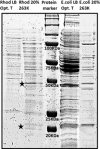Can Halophilic and Psychrophilic Microorganisms Modify the Freezing/Melting Curve of Cold Salty Solutions? Implications for Mars Habitability
- PMID: 32833498
- PMCID: PMC7116095
- DOI: 10.1089/ast.2019.2094
Can Halophilic and Psychrophilic Microorganisms Modify the Freezing/Melting Curve of Cold Salty Solutions? Implications for Mars Habitability
Abstract
We present the hypothesis that microorganisms can change the freezing/melting curve of cold salty solutions by protein expression, as it is known that proteins can affect the liquid-to-ice transition, an ability that could be of ecological advantage for organisms on Earth and on Mars. We tested our hypothesis by identifying a suitable candidate, the well-known psycrophile and halotolerant bacteria Rhodococcus sp. JG3, and analyzing its response in culture conditions that included specific hygroscopic salts relevant to Mars-that is, highly concentrated magnesium perchlorate solutions of 20 wt % and 50 wt % Mg(ClO4)2 at both end members of the eutectic concentration (44 wt %)-and subfreezing temperatures (263 K and 253 K). Using a combination of techniques of molecular microbiology and aqueous geochemistry, we evaluated the potential roles of proteins over- or underexpressed as important players in different mechanisms for the adaptability of life to cold environments. We recorded the changes observed by micro-differential scanning calorimetry. Unfortunately, Rhodococcus sp. JG3 did not show our hypothesized effect on the melting characteristics of cold Mg-perchlorate solutions. However, the question remains as to whether our novel hypothesis that halophilic/psychrophilic bacteria or archaea can alter the freezing/melting curve of salt solutions could be validated. The null result obtained after analyzing just one case lays the foundation to continue the search for proteins produced by microorganisms that thrive in very cold, high-saline solutions, which would involve testing different microorganisms with different salt components. The immediate implications for the habitability of Mars are discussed.
Keywords: Calorimetry; Chaotropism; Cold brines; Extremophiles; Mars; Melting/freeze point; Perchlorates.
Conflict of interest statement
No competing financial interests exist.
Figures



Similar articles
-
Bacterial Growth in Chloride and Perchlorate Brines: Halotolerances and Salt Stress Responses of Planococcus halocryophilus.Astrobiology. 2019 Nov;19(11):1377-1387. doi: 10.1089/ast.2019.2069. Epub 2019 Aug 6. Astrobiology. 2019. PMID: 31386567 Free PMC article.
-
Planning Implications Related to Sterilization-Sensitive Science Investigations Associated with Mars Sample Return (MSR).Astrobiology. 2022 Jun;22(S1):S112-S164. doi: 10.1089/AST.2021.0113. Epub 2022 May 19. Astrobiology. 2022. PMID: 34904892
-
Laboratory Investigations on the Survival of Bacillus subtilis Spores in Deliquescent Salt Mars Analog Environments.Astrobiology. 2017 Oct;17(10):997-1008. doi: 10.1089/ast.2016.1545. Astrobiology. 2017. PMID: 29048223
-
Relevance of Earth-Bound Extremophiles in the Search for Extraterrestrial Life.Astrobiology. 2022 Mar;22(3):322-367. doi: 10.1089/ast.2021.0033. Epub 2022 Feb 2. Astrobiology. 2022. PMID: 35108099 Review.
-
Remarks on Life Feasibility on the Red Planet.Microorganisms. 2025 May 11;13(5):1105. doi: 10.3390/microorganisms13051105. Microorganisms. 2025. PMID: 40431277 Free PMC article. Review.
References
-
- Al Soudi AF, Farhat O, Chen F, et al. (2017) Bacterial growth tolerance to concentrations of chlorate and perchlorate salts relevant to Mars. Int J Astrobiol 16:229–235
-
- Bakermans C and Skidmore M (2011) Microbial respiration in ice at subzero temperatures (−4°C to −33°C). Environ Microbiol Rep 3:774–782 - PubMed
Publication types
MeSH terms
Substances
Grants and funding
LinkOut - more resources
Full Text Sources
Miscellaneous
